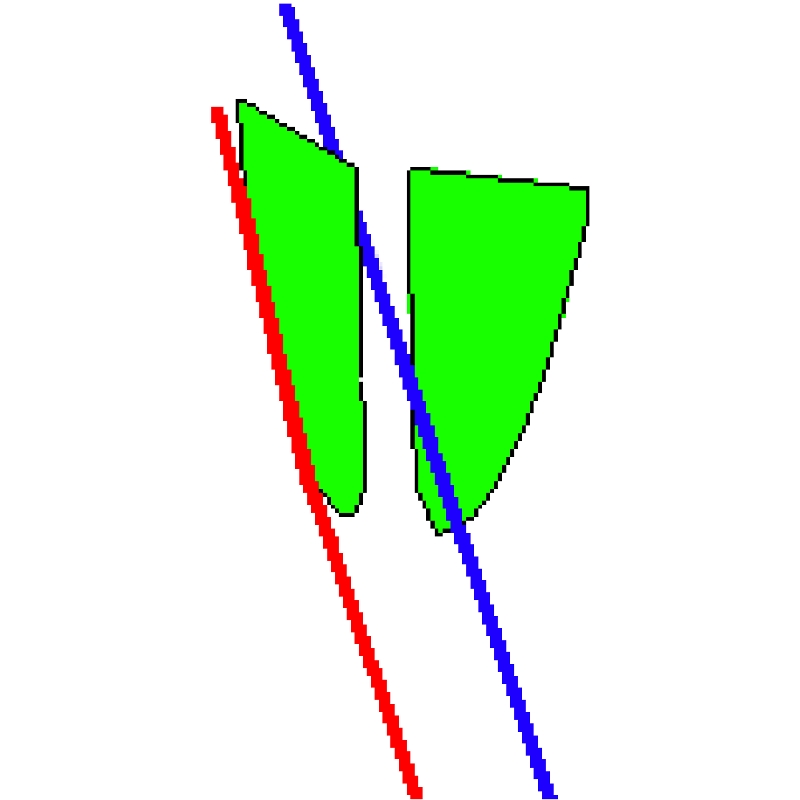
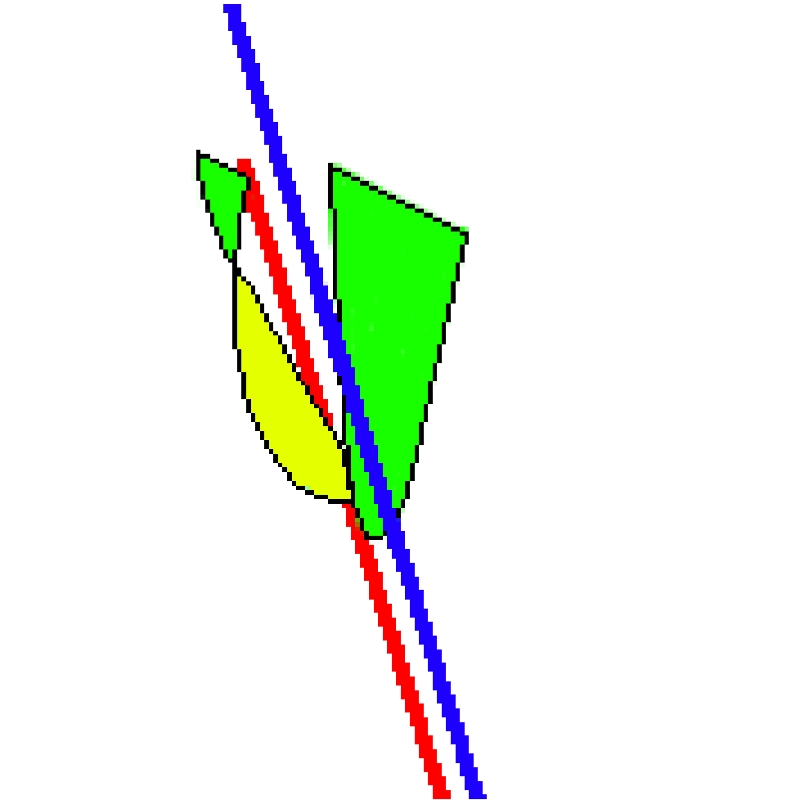
Sandra Carral - carral@mdw.ac.at
Univ. Of Music and Performing Arts, Vienna
Institute of Musical Acoustics
Anton von Webern Platz 1, 1030 Vienna, Austria
Popular version of paper 4pMUa5
Presented Thursday afternoon, November 18
2nd Pan-American/Iberian Meeting on Acoustics
1. Introduction
What can a guitar player do to change the sound of his/her guitar? What parameters or playing techniques does he/she have at his/her disposal to make special sound effects? How is performance technique related to changes in sound while playing the guitar? This paper presents a review of the literature regarding how different ways of plucking the string result in a different sound.
The following parameters will be discussed:
… alongside of examples of how changing these parameters affects the sound of the instrument.
2. Plucking force / Initial string displacement
According to [Cuzzucoli and Lombardo, 1997],
|
“The strength of the plucking force is related to the displacement of the string before release, and hence to the intensity of the sound pressure” |
An experiment was performed at the University of Music and performing Arts, Vienna, whereby a guitar string was plucked with plectra of different thicknesses with the aid of an artificial plucking machine [Carral and Paset, 2008]. The thin plectrum bent considerably more than the thick plectrum. The string displacement was then bigger in the case of the thick plectrum (see Figure 1). The amplitude of the sound, as well as the spectral centroid (which is a measure of how bright the sound is perceived) are plotted in Figure 2. The amplitude of the radiated sound is considerably larger in the case when the string was plucked using the thick plectrum. Looking at the spectral centroid in Figure 2 (b), it starts higher on the thick plectrum, and after about 1 second this situation is reversed. The fact that at larger amplitude the spectrum is richer is an indication of the existence of non linear effects. The spectral centroid being higher on the thin plectrum after about 1 second could be explained by the fact that the string shape was sharper or more angular (as opposed to round), since in that case only the tip of the plectrum was in contact with the string just before release (see Section 4).
3. Plucking position
According to [Campbell and Greated, 1987],
|
“The harmonic composition of a note can be altered by changing the position of plucking. Plucking near to an antinode for a particular mode will excite it, but not other modes which have a node at that point.” |
|
|
|


Figure 1. Schematic of a guitar string plucked with a (a) thin and (b) plectrum, showing the difference in total initial displacement.
|
|
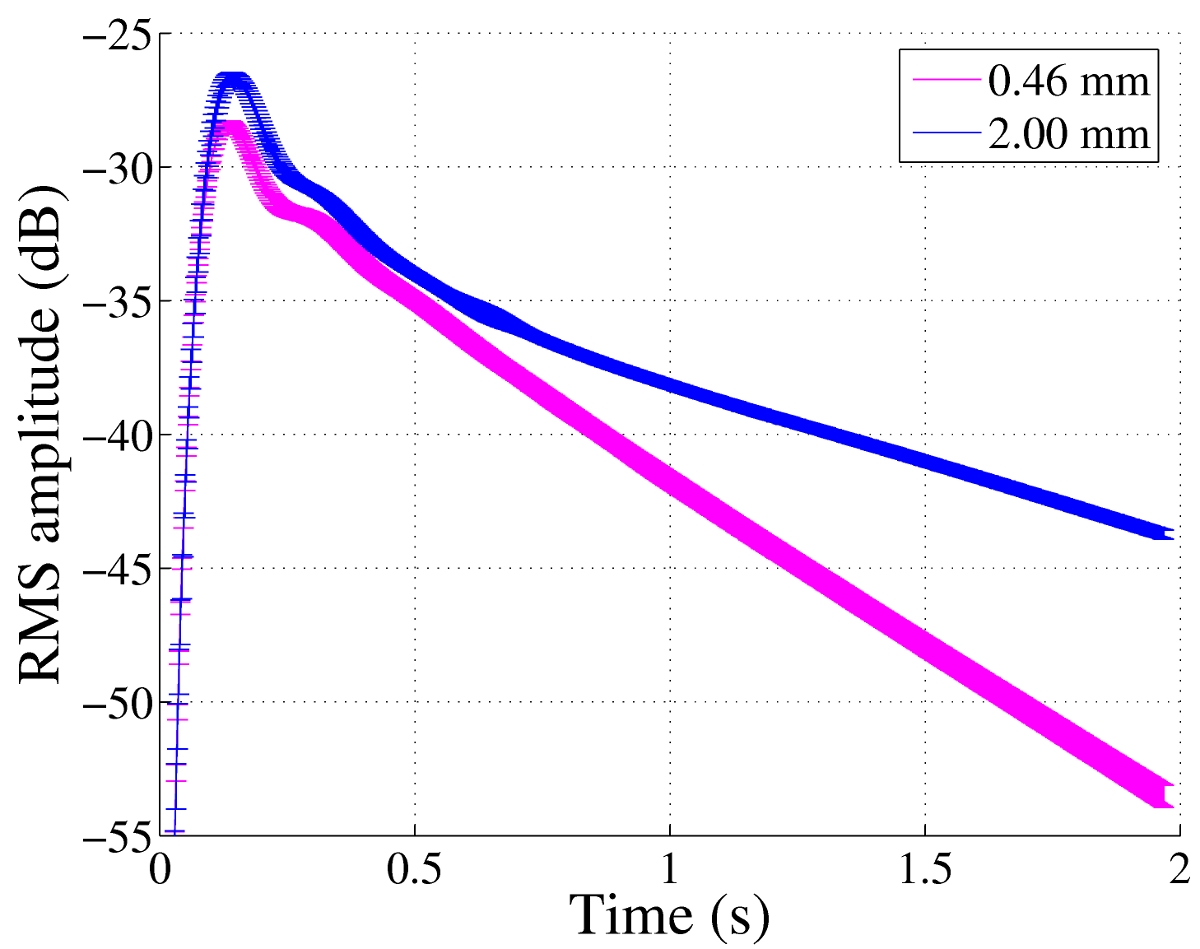
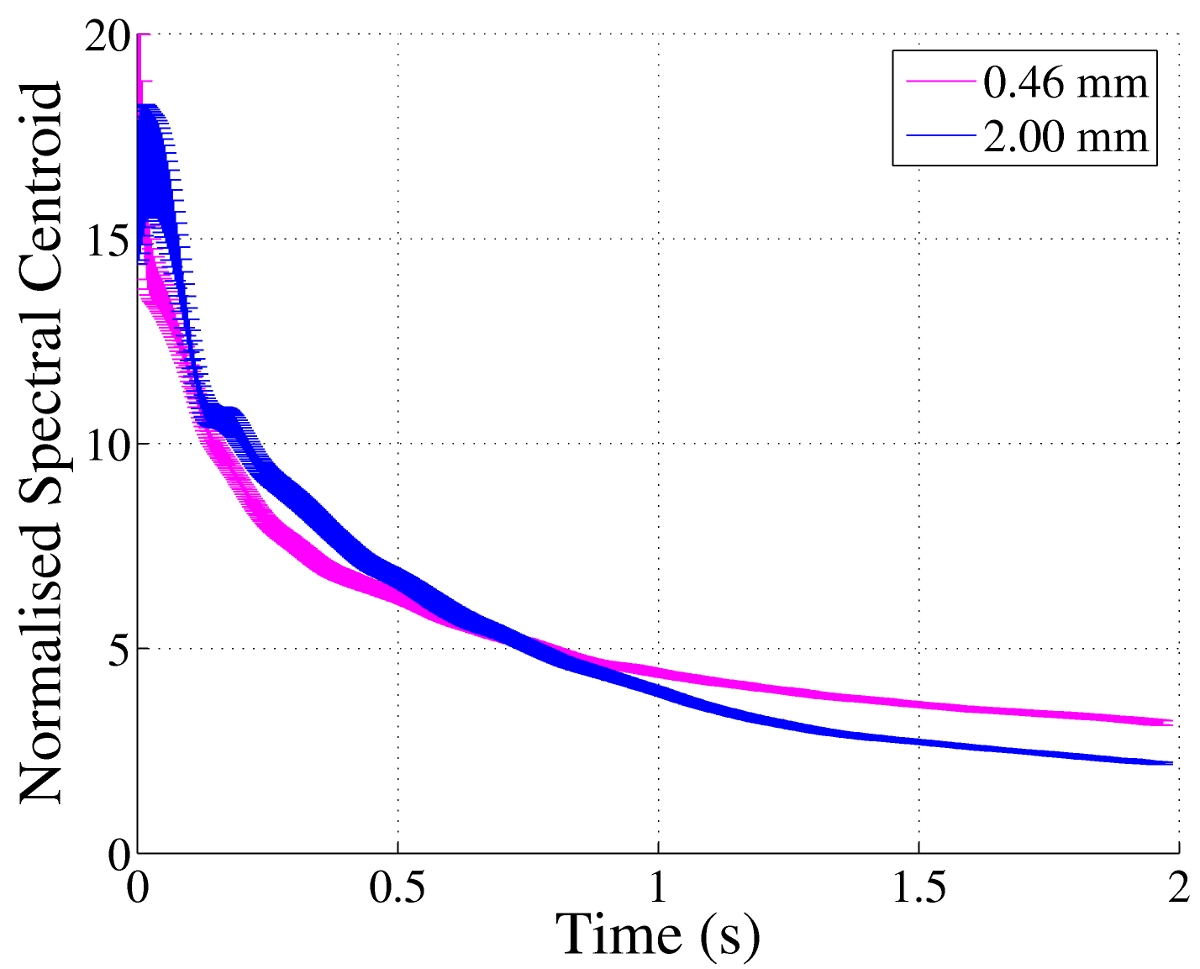
Figure 2. (a) RMS amplitude and (b) spectral centroid variation over time of the open E guitar string plucked by an artificial plucking machine with plectra of thicknesses 0.46 and 2 mm [Carral and Paset, 2008].
With the aid of a linear model provided by James Woodhouse from the University of Cambridge, UK (see [Woodhouse, 2004]), the open E string of a virtual guitar model was plucked at different points along the string. Figure 3 shows the sound spectrum of the guitar when the string was plucked at (a) 1/3 and at (b) 1/5 of the string length from the bridge. The spectrum shown in Figure 3 (a) does not have harmonic components numbers 3, 6, 9, 12, etc., whereas the spectrum in Figure 3 (b) does not have harmonic components numbers 5, 10, 15, etc., thus resulting in a different timbre. As a general rule, plucking closer to the bridge produces a brighter tone.
4. Initial string deformation / Finger width
According to [Campbell and Greated, 1987]:
|
“Plucking with a sharp object such as a plectrum accentuates the higher harmonics in contrast with plucking with the finger or a soft object. This is because the initial displacement is highly angular in form. In order to achieve such a displacement curve... many higher order modes must be introduced, which would not have been the case if the curve had been more rounded” |
|||
|
|
|
||

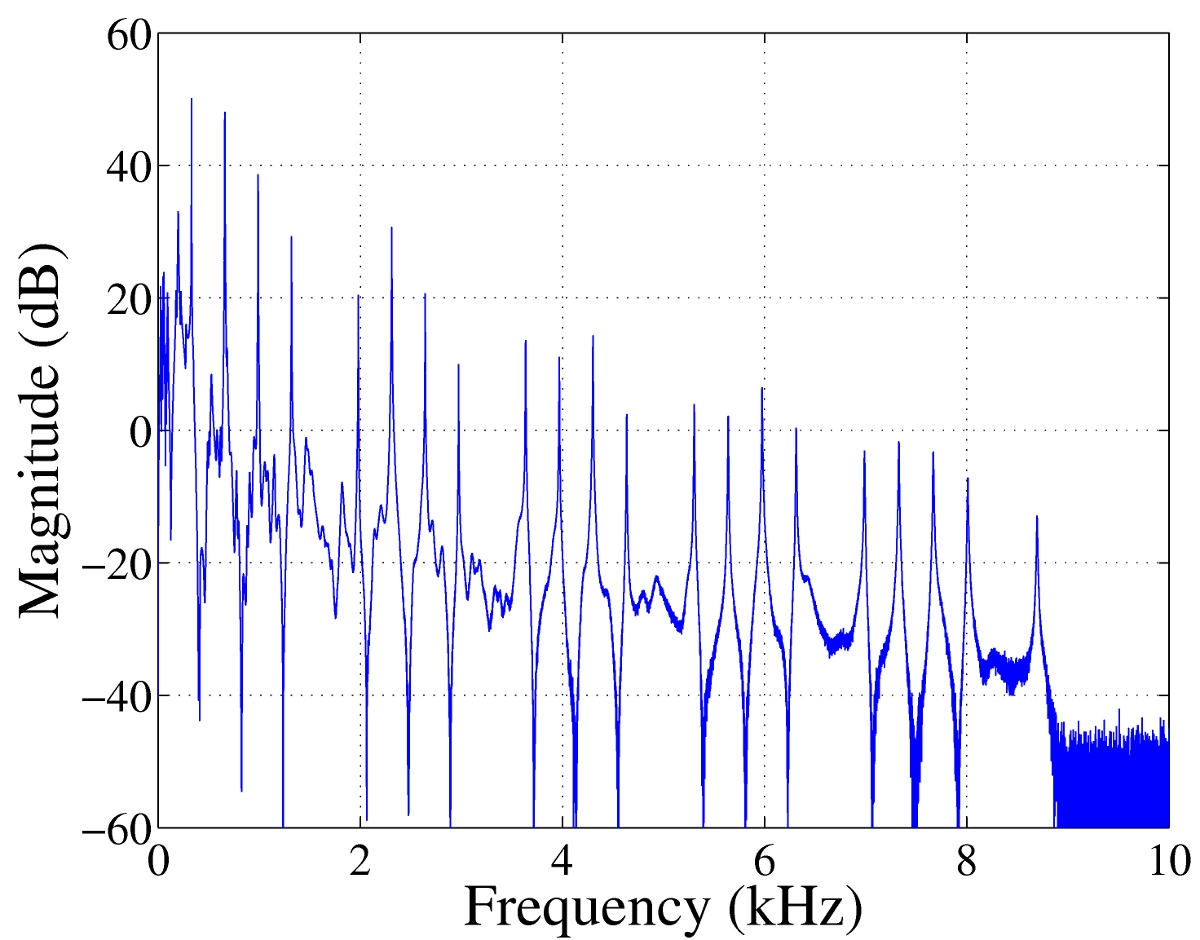
Figure 3. Sound spectrum of a guitar model whose string is plucked at (a) 1/3 and (b) 1/5 of the string length from the bridge. In the case of (a) harmonics 3, 6, 9, 12... are missing, in the case of (b) harmonics 5, 10, 15... are missing.
|
|
|
Figure 4. Sound spectrum of a guitar model whose string is plucked with a finger of width 1 (blue) and 20 (red) mm. |
Figure 4 shows the sound spectrum of a virtual guitar (using the model presented by [Woodhouse, 2004]) when the string was plucked with a finger of width 1 (shown in blue) and 20 (shown in red) mm. The spectrum corresponding to plucking with the thin finger has a larger amplitude in the higher harmonics, resulting in a brighter tone.
5. Plucking angle
According to [Fletcher and Rossing,1998]:
|
“Presumably, a player can greatly alter the tone of a guitar by adjusting the angle through which the string is plucked... When the string is plucked perpendicular to the top plate, a strong but rapidly decaying tone is obtained. When the string is plucked parallel to the plate, on the other hand, a weaker but longer tone results... The spectra of the initial and final parts of the tone vary substantially, as do the decay rates.” |
||
|
|
||
|
Figure 5. Sound spectrum of a guitar model whose string is plucked perpendicular (blue) and parallel (red) to the guitar body, as well as at an angle of 45 degrees (green) |
||
|
|
|


Figure 6. Sound pressure evolution over time of the open A string plucked (a) vertically (perpendicular) and (b) horizontally (parallel) relative to the guitar body (taken from [Wright, 1996], page 54, printed with author's permission).
Figure 5 shows the sound spectrum of a virtual guitar (using the model presented by [Woodhouse, 2004]) when the string was plucked perpendicular (blue) and parallel (red) to the guitar body, as well as at a 45 degree angle. In the parallel case all harmonics have smaller amplitude, indicating that the overall amplitude of the sound is smaller than in the two other cases. Figure 6 shows the time domain sound pressure evolution over time of the sound. In the perpendicular case (a) the amplitude at the onset of the note is much bigger than on the parallel case, but dies away more quickly, whereas in the parallel case (b) the note “rings” for much longer.
References
[Campbell and Greated, 1987] Campbell, M. and Greated, C. (1987). The musician’s guide to acoustics. Schimer Books.
[Cuzzucoli and Lombardo, 1997] Cuzzucoli, G. and Lombardo, V. (1997). Physical model of the plucking process in the classical guitar. In Proceedings of the International Computer Music Conference, pages 172–179, Aristotle University of Thessaloniki, Greece. International Computer Music Association and Program of Psychoacoustics of the Aristotle University of Thessaloniki.
[Fletcher and Rossing, 1998] Fletcher, N. H. and Rossing, T. D. (1998). The physics of musical instruments.
Springer, second edition.
[Woodhouse, 2004a] Woodhouse, J. (2004a). On the synthesis of guitar plucks. Acta Acustica united with Acustica, 90:928–944.
[Woodhouse, 2004b] Woodhouse, J. (2004b). Plucked guitar transients: Comparison
of measurements and synthesis. Acta Acustica united with Acustica,
90:945–965.
[Wright, 1996] Wright, H. (1996). The acoustics and psychoacoustics of the
guitar. PhD thesis, University of Wales.